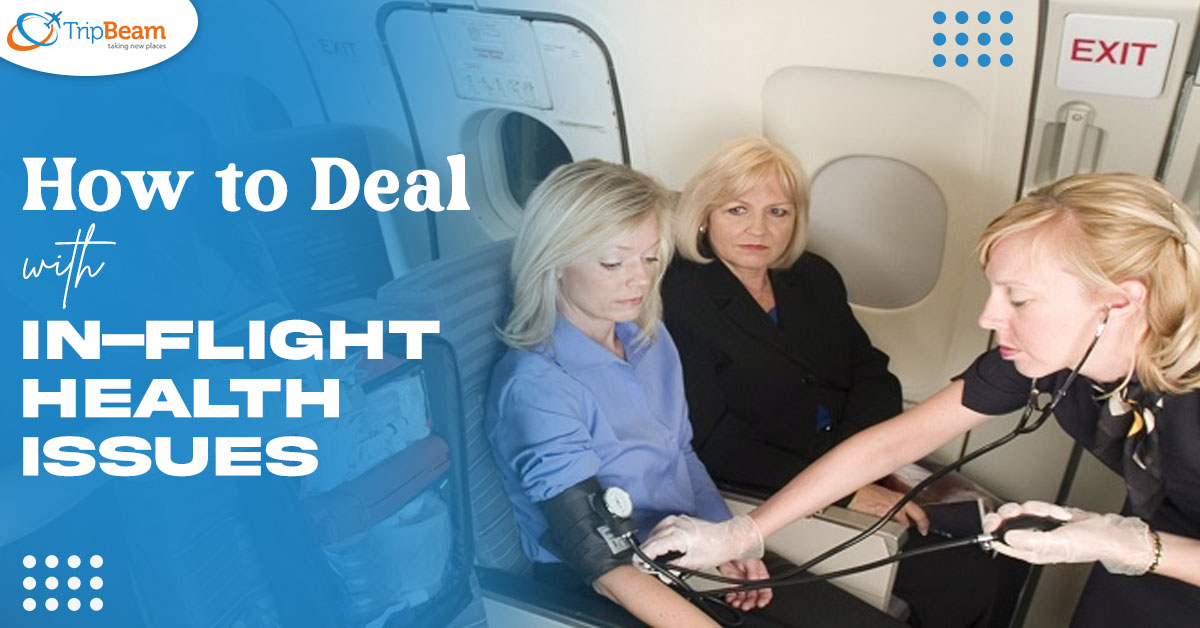In-flight medical situations offer opportunities to respond swiftly and effectively, particularly when travelling on cheap tickets to India from USA. If this is acute sickness or injury, these occurrences necessitate immediate treatment and expert aid inside the constraints of an airplane. This article on Tripbeam explains the complications of dealing with medical crises during air travel, demonstrating the importance of readiness, teamwork, and medical proficiency in assuring the security and health of all passengers on board.
What is the likelihood that you will experience this?
Assessing the prevalence of in-flight medical emergencies (IMEs) presents challenges due to inconsistent reporting and reliance on ground-based medical support, which is typically not consulted during flights. Estimates indicate around 1 in 604 flights experience an IME, while other data suggests a range of 24 to 130 incidents per 1 million passengers. With approximately 4 billion passengers flying annually, this results in 260 to 1420 emergencies occurring daily worldwide. Consequently, depending on your frequency of air travel, especially when flying with cheapest business class flights to India from USA, you may be summoned to provide aid.
What will you typically observe?
In-flight medical emergencies (IMEs) are most commonly attributed to syncope or pre-syncope, making up around 33-37% of occurrences. Other prevalent issues encompass gastrointestinal symptoms (15%), respiratory ailments (10-12%), cardiovascular complaints (7-8%), seizure or post-ictal state (6%), psychiatric conditions (4%), allergic reactions (2%), suspected stroke (2%), diabetes complications (2%), obstetric emergencies (0.7%), and cardiac arrest (0.2-0.3%). About 4% of IMEs result in flight diversion.
What differences exist in the environment?
Commercial aircraft cabins are pressurized to levels equivalent to 5000-8000 feet elevation, causing gas expansion by approximately 30%. This pressure variation can impact anatomical spaces containing gas, such as sinuses and middle ear, and exacerbate non-physiologic gas collections like pneumothorax or post-operative air collections.
Do you need to volunteer? Are you safe if you do?
Aside from ethical considerations, individuals may wonder about their legal obligations to volunteer during in-flight medical emergencies (IMEs). In the United States, Canada, England, and Singapore, physicians are not legally required to assist. While in Australia, certain European countries, and Quebec, Canada, they may be. However, if you do choose to volunteer, proof of credentials is typically not required on US flights, though this may vary by airline.
Medical professionals who volunteer in IMEs in the US are protected from liability under the Good Samaritan provision of the Aviation Medical Assistance Act, except in cases of gross negligence or willful misconduct. Seeking compensation for assistance, such as miles or monetary rewards, may jeopardize this immunity. While airlines can face legal action for conduct during IMEs. There has been only one reported case in the US of a medical professional being sued for volunteering. And the case was dismissed without a hearing.
What type of equipment and meds do you have?
In the United States, airlines are mandated to carry essential medical equipment, covering assessment, airway/breathing, and intravenous access. Depending on the airline, additional supplies may also be available.
Internationally, the International Civil Aviation Organization (ICAO), a United Nations agency, oversees flight safety and advises on onboard medical supplies. Although recommendations exist, they are not obligatory, leading to variations in supplies among countries and airlines.
Furthermore, minimum medication requirements are set for onboard use, with additional medications varying by airline and international regulations.
What should you know about any specific scenarios?
- Cardiac Arrest
While cardiac arrests are rare causes of in-flight medical emergencies (IMEs) at 0.2-0.3%, they contribute to 86% of in-flight deaths. Crew members should be proficient in CPR and AED operations, allowing them to focus on tasks like IV access and medication administration. Compression-only CPR is viable, with CPR masks available if adequate assistance is present. Ceasing resuscitation efforts in an IME is challenging, but some experts suggest it after 20-30 minutes without a return of spontaneous circulation. Death can only be declared by a physician in flight.
- Respiratory Compromise
Aircraft are not mandated to carry oximeters, and while US planes do have oxygen tanks, they are limited to low (2L/min) or high (4L/min) flow rates. COPD exacerbations are common, necessitating the availability of bronchodilators onboard.
Requesting a descent to a lower altitude to improve oxygenation is feasible. Although it poses challenges due to increased fuel consumption at lower altitudes. Reported cases of pneumothoraces highlight the importance of having needles onboard for needle thoracostomy. Descending to a lower altitude may aid oxygenation and gas expansion in such cases.
- Acute Coronary Syndrome
If acute coronary syndrome (ACS) is suspected, aspirin 325mg is available onboard and can be administered if there is no active bleeding or true allergy. However, sublingual nitroglycerin onboard should be used cautiously, as there is no means to rule out a right ventricular infarct.
- Altered mental status
The availability of glucometers may differ between airlines. An alternative could involve seeking assistance from fellow passengers, although this may compromise sterility and patient privacy.
In-flight hypoxemia and disruptions in circadian rhythms may lower the seizure threshold, highlighting the importance of maintaining a high index of suspicion. Suspected stroke is also a frequent cause of flight diversion.
Summary
In-flight medical emergencies (IMEs) can present significant challenges due to limited diagnostic tools. And a finite supply of medications and supplies to address diverse and potentially life-threatening conditions. Nonetheless, as emergency physicians, we are among the most equipped professionals to manage such demanding situations. By delivering care that aligns with our usual standards, the likelihood of facing liability is exceedingly low. However, exercising caution when accepting compensation is imperative to safeguarding your legal immunity. It’s crucial to remember that you’re never alone, and the decision to divert an aircraft will always involve the support of the ground medical team, especially when dealing with last minute flights to India from USA.
Also Read: Travel On Flight Tickets To India And Improve Your Mental Health


